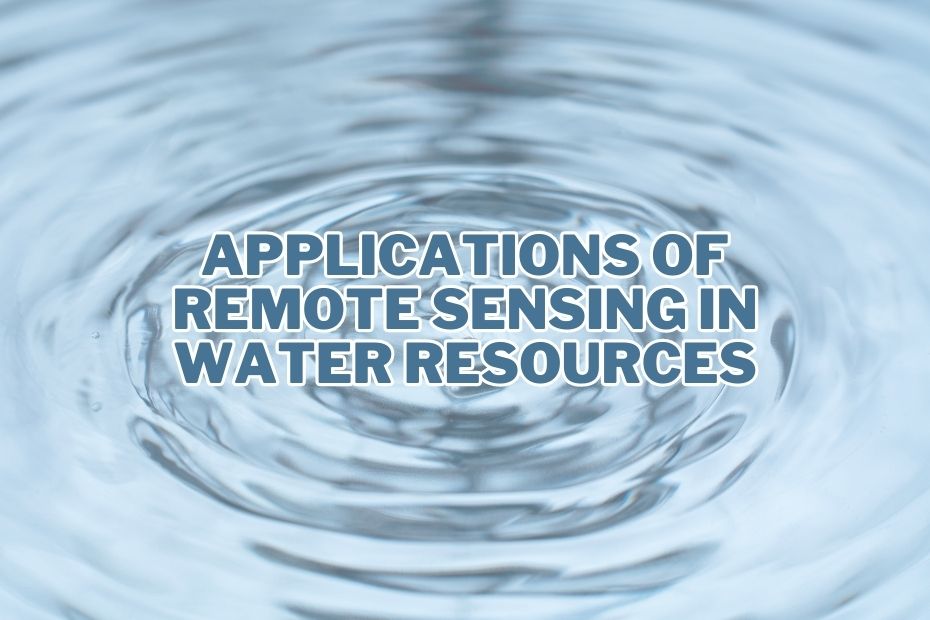Remote sensing, a cutting-edge technology that involves the collection of data from a distance, has found remarkable applications in various fields. One of its most vital applications is in water resources management. In this article, we delve into the diverse application of remote sensing in water resources, exploring its significance in monitoring, mapping, and managing water-related issues.
ez-toc]
Application of Remote Sensing In Water Resources
Water resources are essential for life on Earth, and their sustainable management is critical for the well-being of both humans and the environment. Remote sensing, a technique of obtaining information from a distance, has emerged as a powerful tool to collect data on water resources.
1. Assessing Water Availability
Remote sensing plays a pivotal role in assessing water availability, a critical factor for sustainable water resource management. Satellite-based sensors provide comprehensive data on various water bodies, including lakes, rivers, and reservoirs. These sensors measure the surface area, volume, and water levels of these bodies, enabling us to track changes over time. This information aids in understanding water availability trends, identifying water-stressed regions, and making informed decisions for water allocation and distribution.
2. Monitoring Water Quality
Ensuring the quality of water resources is essential for human health and the environment. Remote sensing technologies assist in monitoring water quality by detecting parameters such as turbidity, chlorophyll concentration, and temperature. The sensors can identify pollutants and harmful algal blooms in water bodies, helping authorities take timely actions to safeguard water quality and public health.
3. Detecting Water Pollution
Remote sensing offers an effective means of detecting water pollution sources and monitoring their spread. By using specialized sensors, it becomes possible to identify and track pollutants like oil spills, chemical discharges, and sediment runoff. This early detection aids in mitigating the environmental impact of pollution, reducing harm to aquatic ecosystems and biodiversity.
4. Mapping Watershed Boundaries
Understanding the boundaries and characteristics of watersheds is crucial for managing water resources sustainably. Remote sensing allows for the mapping of watershed boundaries and delineating their drainage patterns. This information facilitates water resource planning, flood risk assessment, and land use management, ensuring optimal water utilization within each watershed.
5. Measuring Surface Water Flow
Remote sensing techniques enable the measurement of surface water flow in rivers and streams. By utilizing radar and optical sensors, scientists can track the flow velocity and volume of water bodies. This data is valuable for flood forecasting, hydroelectric power generation, and managing water resources during periods of heavy precipitation.
6. Estimating Snow and Glacier Parameters
Remote sensing contributes significantly to monitoring snow cover and glacier parameters in cold regions. Satellite-based sensors can measure snow depth, extent, and melt patterns, helping assess water availability for regions dependent on snowmelt for their water supply. Additionally, glacier monitoring aids in understanding the impact of climate change on water resources in mountainous areas.
7. Flood Monitoring and Forecasting
Floods pose significant threats to lives, properties, and ecosystems. Remote sensing technology allows for real-time flood monitoring by assessing water levels and inundation extents during rainfall events. This data helps emergency responders and authorities to prepare for floods, evacuate at-risk populations, and implement flood control measures.
8. Drought Assessment and Prediction
Droughts can have devastating consequences on agriculture, water supply, and the environment. Remote sensing aids in drought assessment by monitoring soil moisture, vegetation health, and water levels in reservoirs. This information assists policymakers in predicting drought events and implementing water conservation strategies to mitigate their impacts.
9. Groundwater Exploration
Groundwater is a crucial source of water supply, especially in arid regions. Remote sensing helps in locating potential groundwater reservoirs by mapping subsurface geological structures and identifying areas with high groundwater potential. This valuable information supports sustainable groundwater management and prevents overexploitation of this vital resource.
10. Irrigation Management
Efficient irrigation practices are essential for sustainable agriculture and water conservation. Remote sensing provides data on crop health, soil moisture, and evapotranspiration rates, allowing farmers to optimize their irrigation schedules. This technology enhances water use efficiency, minimizes water wastage, and improves crop productivity.
11. Wetland Mapping and Monitoring
Wetlands are ecologically significant habitats that play a vital role in water filtration and biodiversity conservation. Remote sensing enables accurate mapping and monitoring of wetland areas. By assessing changes in wetland extents and vegetation, scientists can monitor their health and advocate for their preservation and restoration.
12. Coastal Zone Management
Coastal zones are vulnerable to various environmental challenges, including erosion, pollution, and rising sea levels. Remote sensing aids in monitoring coastal changes, assessing shoreline erosion, and detecting coastal pollution sources. This data informs coastal zone management strategies and supports the conservation of coastal ecosystems.
Conclusion
The application of remote sensing in water resources management has revolutionized the way we monitor, map, and manage water-related issues. From assessing water availability to monitoring water quality and detecting pollution sources, remote sensing provides valuable data to make informed decisions for sustainable water resource management.
As technology continues to advance, remote sensing is expected to play an increasingly vital role in safeguarding one of our most precious resources—water.
FAQs: Application of Remote Sensing In Water Resources
How does remote sensing aid in flood monitoring and forecasting?
Remote sensing technologies can assess real-time water levels and inundation extents during rainfall events. This data helps in preparing for floods, implementing flood control measures, and protecting communities and ecosystems.
Why is monitoring water quality essential?
Monitoring water quality is crucial for human health and the environment. Remote sensing technologies detect pollutants and harmful algal blooms, enabling authorities to take timely actions to safeguard water quality and public health.
How does remote sensing help in detecting water pollution?
Remote sensing can detect water pollution by analyzing the spectral properties of water bodies, identifying the presence of pollutants and changes in water quality.
What role does remote sensing play in coastal zone management?
Remote sensing monitors shoreline changes, sea level rise, and coastal erosion, providing essential data for effective coastal zone management and disaster preparedness.
